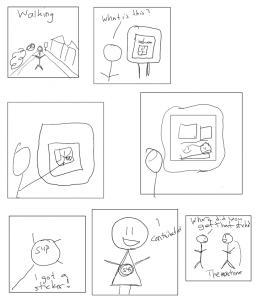Hello again,
During this week’s lecture we listened to a representative from the group SPACE for Gosforth. What he talked about is very much relevant for our project since the group wants to make Gosforth more amiable for cyclists. However, the area of Gosforth is not a part of the Streets for people campaign which makes it harder for them to evoke change. So while the council aims to change people’s way of transport via physical changes of the streets the SPACE for Gosforth aims to change people’s way of transport through an attitude change first and then physical changes of the streets. When we talked to the stakeholders one of the problem that came up was that the public did not understand why the council was changing the area. We’ve discussed this before and decided that we in our product will add information not just about the planned changes but also about Streets for people.
During the seminar and our meeting we started discussing the outline of our storyboard and user experience as well as starting to draw it. All in all we’re thinking about 7-8 storyboard panels for demonstrating the use of our product. Below is the basic outline sketch of the storyboard.

It is important for us to include the most important uses for our product, informing and gaining feedback, together with the sticker concept as a mean to spread the word. The setting will be outside and since we’re hoping to get a lot of response from students, who to a lesser degree have cars, we don’t think this will be a drawback. We’re also thinking about having a second display with the same software in an inside setting as well, for example in the library.
Hello team, thanks for the first go at your story board and for posting some reflections on the in-class guest talk by Ali. It appears that you have had similar observations to Ali when you note that many residents may not have been aware of Streets for People and the changes that are being proposed and why they occur. It seems to make sense to give a bit of background context to the campaign that stands behind the proposed road infrastructure amendments. (just to not that Gosforth is also covered by the S4P program).
Your storyboard is helpful in that it shows the context and use of your digital concept in general. It manages to hint as to the context of use (street level); it hints broadly that participants will be shown some proposed changes (albeit it is not so clear whether there is anything distinctive or innovative in the way that will be done). It also indicates rewards for users. Overall your design indicates three different kinds of motivations: that of curiosity of seeing something unusual in the street, the potential reward from monetary or other similar toke (monetary or reputation incentives). And eventually social feedback. You could perhaps discuss those different kinds of motivators further. And indicate how those relate to what you found in your earlier example search. For the final reflective log, you could perhaps consult the article on story boarding we have got on blackboard in your final discussion as to why you developed the story board you developed; and how you decided what needs to be included or not.
Hi team! An interesting blog and it’s good to see that you’re linking the lecture material into your blog posts too, and considering how this could affect the decisions you make about your prototype.
I like that your storyboard takes account of the context within which it will be used. I think it would be good to consider whether that ‘story’ would change if it was in an indoor location as you suggest. For your final reflective log it would also be good to go into more detail as to how your storyboard was developed and how it links to the objectives of your system. This will help to closely link the decisions you’ve made to the objectives you set yourselves. Great blog!